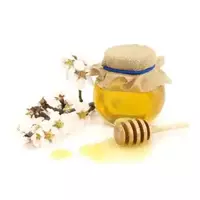May honey

The name of this type of honey is directly due to the collection time of nectar for the manufacture of this natural product. May honey, which is otherwise called the first honey, is harvested by hardworking bees from garden trees and shrubs, which are the first to bloom in May. Due to this, the taste of May honey includes the symbiosis of a wide variety of species of plants blooming in May: willow, maple, sour, bird cherry, strawberries, sage, currants, cherries, apple trees and many others.
It is noteworthy that May honey is one of the most sought-after varieties of this aromatic natural treat - it is most often asked. The color of May honey can be completely different - the color of the sweetness undoubtedly depends on which trees or plants the bees collected nectar from. So, the color of May honey can vary from sunny yellow to almost brown.
In the spring season, bee hives transform into nurseries, where thousands of small future workers need nectar and pollen for development and growth. That is why all the sweet raw materials that caring bees collect in May are given to babies, and directly pumping honey begins only at the very beginning of June.
By the way, immediately after pumping out, May honey does not stand out in particular, representing a pale syrup with a greenish tint. However, after the ripening process, which usually lasts from three to five months, honey miraculously acquires a unique bright aroma with subtle notes of menthol cool. Moreover, among other varieties, May honey is rightfully considered one of the sweetest.
It is quite difficult to overestimate the useful properties of May honey, because this natural product is rich in fructose, due to which its absorption by the human body is much easier and faster compared to other varieties. As you know, the absorption of fructose, even in considerable quantities, does not require the participation of insulin - accordingly, diabetes does not develop. In addition, fructose has a beneficial effect on the processes of hematopoiesis in the body.
Regular consumption of May honey for food returns vigor, cheerfulness and excellent mood. It has been proven that the useful properties of May honey are relevant for atherosclerosis, nervous diseases, insomnia, as well as diseases of the organs of vision.
Depending on the components of this miraculous product, its effect on humans may be focused on each specific area of the body. For example, when hawthorn prevails in May honey, it is used to increase the functions of the thyroid gland and with cardiac weakness. At the same time, the first honey with a predominance of acacia is an indispensable means of treating young children, since often babies are allergic to tart species.
May honey 304 kCal
Energy value of May honey (Ratio of proteins, fats, carbohydrates - ju):
Proteins: 0.3 g (~ 1 kCal)
Fats: 0 g (~ 0 kCal)
Carbohydrates: 82.4 g (~ 330 kCal)
Energy ratio (bj | y): 0% | 0% | 108%
 Español
Español Français
Français Português
Português Русский
Русский 简体中文
简体中文 繁體中文
繁體中文 日本語
日本語 한국어
한국어 العربية
العربية Türkçe
Türkçe Қазақ
Қазақ Deutsch
Deutsch Italiano
Italiano Українська
Українська
